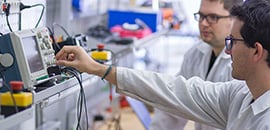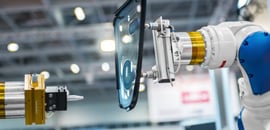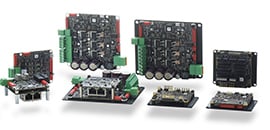Overview
This paper discusses how the output current of servo drives is specified. Standard industry terminology is explained. The paper concludes with examples of how to convert rms and crest ratings for sinusoidal, trapezoidal and DC servo drives.
Understanding RMS and crest currents
The following is a simplified electrical drawing of a typical 3 phase servo drive system using sinusoidal commutation:
 Figure 1
Figure 1
On a permanent magnet brushless AC motor that is rotating at a constant speed, the phase currents will have a sinusoidal waveform with a 120º delay between them, theoretically. For constant speed applications, the current is sometimes expressed in Root Mean Square or RMS (see detailed description below). The RMS value of those currents in that situation can be calculated as crest current / √2. For example, if your BLAC motor is rated at 17 ARMS it means the crest current will be 24 A at this rated point. However, although RMS current is commonly used in the industry for continuous power applications, it does not provide a clear answer for a detailed design of many robotics applications where the frequency is not constant and the motor can be fixed on a position. At these points, the calculation or measurement of RMS current using a typical device or multimeter could lead to non-practical results.
Because of this fact, Celera Motion’s Ingenia manuals and documentation – if not specified otherwise – show the current expressed as the crest value of the phases. The software also shows either the instantaneous value for the individual phase currents or the computed “current actual value”, which matches the crest positive value of the instantaneous currents.
Naming convensions
To keep the explanation free of ambiguities, consider this nomenclature:
- Instantaneous value (A): Value of the current in a specific moment in time. It is the current you would measure with an oscilloscope and a current probe on the specific motor phase.
- RMS value (ARMS): Root Mean Square current, which is computed over a period of time by making the square root of the average square values of the instantaneous currents. This current is the equivalent DC current that would produce the same power dissipation in a resistive load. It is the current you would measure with a True RMS multimeter connected in series with the motor phases. Conversion between RMS and crest values will be presented later.
- Crest value (A): Maximum value for alternating current. It can be referred to as “peak” value, which is an ambiguous and confusing term. Note this term is sometimes referred to as “peak amplitude“.
- Peak to peak amplitude (A): 2 times the crest value for a symmetrical current, corresponds to the peak to peak value of the signal.
- Nominal value (ADC or ARMS): the maximum value of continuous current that causes such power dissipation that the drive can withstand it for an infinite amount of time, assuming that the environmental conditions described in the manual (ambient temperature range, presence of a heatsink, etc.) are met.
- Peak value (ADC or ARMS): the value of transient current that causes such power dissipation that the drive can withstand it for a defined peak time, assuming that the environmental conditions described in the manual (ambient temperature range, presence of a heatsink, etc.) are met.

Figure 2
Drive current levels description
The servo drive has several current levels or limits. Some of them correspond to registers in the firmware.
- Current in Product Part Number: this typically refers to the nominal crest current. Depending on the product line this criteria may change as in some drives it is specified in RMS.
- Short-circuit Threshold (A): Instantaneous current where the hardware short-circuit protections will cut the flow of current. This value shows a large tolerance, the protections are fast (typically under 1 µs) but not accurate.
- Maximum Readable Current (A): Maximum value of current that can be read by the Analog to Digital Converter (ADC) before it saturates. o Whenever the application maximum current < Maximum Readable current, the drive can protect the motor using i2t algorithms and control the current. o Whenever the maximum current > Maximum Readable current, the firmware will not control the current and the current waveforms may show distortion. It is not recommended to saturate the current readings.
- Drive Peak Current (A): Value of the transient current that the drive can only withstand for a given Drive Peak time, under given conditions of ambient temperature and thermal dissipation. This value is expressed as crest unless otherwise specified. It depends on the heat capacity of the power stage and the cold plate rather than the heatsink size and area.
- Drive Nominal Current (A): Value of continuous current that the drive can withstand indefinitely, under given conditions of ambient temperature and thermal dissipation. Any current larger than this can trigger the drive’s i2t algorithm.
- Motor Peak Current (A): User-configured peak current that the motor can withstand for specific peak time. It is expressed as DC current. If the motor datasheet has the information in ARMS, convert it to crest using the criteria shown below.
- Motor Rated/Nominal Current (A): User-configured maximum continuous current of a motor for a specific application. Any current larger than this triggers the Motor i2t algorithm (starts integrating). This current value should never be set higher than the rated current value of the motor datasheet.
 Figure 3 – Servo drive current levels
Figure 3 – Servo drive current levels
Conversion from crest current to RMS
Depending on the type of motor and/or the commutation method/mode, one of these current modes shall be met. In each case, the RMS current can be easily approximated:
| Sinusoidal mode In sinusoidal mode, the motion controller provides phase currents with the form of a sine wave (outphased 120 degrees from each), and the 3 phases conduce current during the whole electric cycle in a way that any of them is the algebraic sum of the other 2 at all time. Therefore, the resulting torque is flat (ideally). This is accomplished by a control algorithm called Space Vector Modulation. Whenever the currents match the shape of an ideal sine, the RMS value can be calculated as: IRMS = ICREST / √2 |  |
| Trapezoidal mode In trapezoidal mode, the motion controller modulates the voltage to fit the shape of a trapezoid. In this scenario, only 2 phases are active at the same time, matching the flat sections of the trapezoid, and the 3rd is left floating. Therefore, the current is positive in the phase modulated with positive voltage, it is negative in the phase modulated with negative voltage, and there is no current at all in the phase left floating, in which the observable voltage is the BEMF changing from positive to negative or vice-versa. The resulting torque shows a characteristic ripple, which is product of the fact that each 1/6th of the cycle a DC excitation is applied over a rotating magnetic field, so the resulting torque is proportional to the sine of the angle between the rotor and the excitation. As the current can be approximated to ideal square waves, the approximate RMS value of the current can be calculated as: IRMS = ICREST * 2/3 With ICREST being the value of the current in DC during the flat section. In the diagram, the BEMF of each phase is shown in dashed line. Torque and current is shown in solid line. |  (This torque response might depend on the internal construction of the motor) (This torque response might depend on the internal construction of the motor) |
| DC mode In DC mode, the current is simply proportional to voltage, therefore the controller must only modulate voltage in accordance with the required torque and direction. The RMS value of the current can be calculated as: IRMS = IDC In the diagram, voltage of each phase is shown in dashed line and current is shown in solid line. |  |






